Find out how crane systems can increase productivity and improve worker safety in an industrial warehouse.
What is a Crane?
A crane is an overhead lifting mechanism that allows you to quickly and safely lift and transport heavy items around your warehouse. These machines use hoists, ropes, or chains to lift objects vertically off the ground before transporting them into your intended location.
You can also customize these machines to the needs of your operation. They offer a wide range of weight capacities from 250 lbs up to 15,000 lbs. In addition, they can improve your operation’s workflow while minimizing strain on your employees and reducing the risk of accidents.
Types of Cranes for Industrial Warehouses
Several different crane systems are used in warehouses, including workstations and jib cranes. Workstation cranes feature a bridge-like structure and move loads vertically and horizontally across a track system. Jib cranes feature a mast and arm that rotates to move loads around your facility. Keep reading to learn more about each type of crane.
Workstation Cranes and Monorails
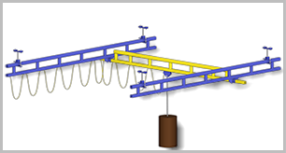 Workstation cranes are also known as bridge cranes and are ideal for warehouses that require horizontal transportation. They can be manual, motorized, or pneumatic, depending on your needs.
Workstation cranes are also known as bridge cranes and are ideal for warehouses that require horizontal transportation. They can be manual, motorized, or pneumatic, depending on your needs.
Workstation Cranes
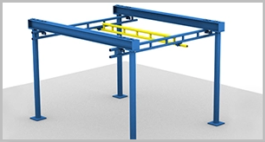 Workstation cranes run on fixed tracks and come in single and double girders. Girders are the beams that run across the crane’s length and allow the hoisting mechanism to travel horizontally. They are ideal for assembly lines and other applications.
Workstation cranes run on fixed tracks and come in single and double girders. Girders are the beams that run across the crane’s length and allow the hoisting mechanism to travel horizontally. They are ideal for assembly lines and other applications.
Gantry Cranes
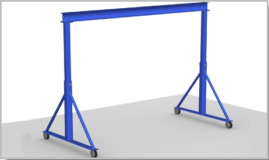 A gantry crane is a crane that is built on a gantry or portable frame, typically on wheels. These cranes are highly versatile and can be used in smaller operations like automotive shops and large-scale operations.
A gantry crane is a crane that is built on a gantry or portable frame, typically on wheels. These cranes are highly versatile and can be used in smaller operations like automotive shops and large-scale operations.
Workstation Monorails
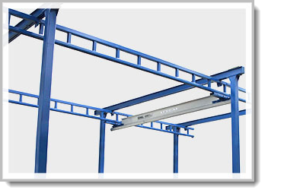 Workstation monorails allow you to lift large loads on a track. They are often used in assembly lines. Unlike a workstation crane which carries loads on an X, Y, and Z axis, workstation monorails can only move objects up and down.
Workstation monorails allow you to lift large loads on a track. They are often used in assembly lines. Unlike a workstation crane which carries loads on an X, Y, and Z axis, workstation monorails can only move objects up and down.
Jib Cranes
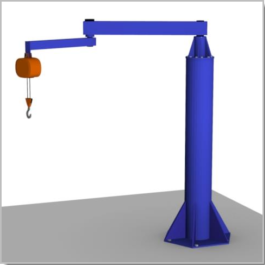 Jib cranes are designed for lifting jobs that require more versatility. These cranes feature a vertical mast, an arm or boom, and a hoist to lift objects. These cranes can move things vertically and horizontally and can offer a 360-degree range of motion. These cranes may be freestanding, floor-mounted, or wall-mounted, requiring little floor space.
Jib cranes are designed for lifting jobs that require more versatility. These cranes feature a vertical mast, an arm or boom, and a hoist to lift objects. These cranes can move things vertically and horizontally and can offer a 360-degree range of motion. These cranes may be freestanding, floor-mounted, or wall-mounted, requiring little floor space.
Jib cranes are ideal for smaller workspaces and large warehouses and can be combined with overhead cranes for maximum efficiency. Jib cranes come in a wide range of sizes and can also be manual, pneumatic, or motorized.
Freestanding Jib Crane
Freestanding jib cranes are secured to the floor of your operation and require a substantial foundation for support. They are ideal for heavy production operations and can be motorized for precise handling.
Mast-Type Jib Cranes
These jib cranes are secured into the ceiling and floor for additional security. This means they don’t require as much foundation as a freestanding jib crane. They are very versatile and can be used for repetitive lifting tasks.
I-Beam Jib Cranes
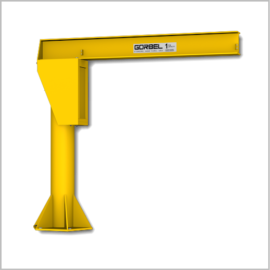 These jib cranes feature a beam that allows you to slide your load horizontally and vertically. This will enable you to position your load precisely.
These jib cranes feature a beam that allows you to slide your load horizontally and vertically. This will enable you to position your load precisely.
Articulation Jib Cranes
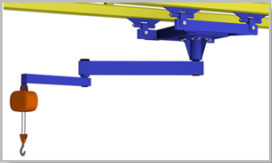 Articulation jib cranes offer additional flexibility when it comes to moving loads. This type of crane features an extra joint along the arm, giving it more precision.
Articulation jib cranes offer additional flexibility when it comes to moving loads. This type of crane features an extra joint along the arm, giving it more precision.
Applications for Cranes in Industrial Warehouses
Cranes offer a wide range of applications in warehouse settings. They can range in capacity from 250 lbs for lighter loads up to fifteen tons or more and can be customized to fit your space. Some applications include:
Assembly
Overhead cranes allow you to move parts and raw materials efficiently through the assembly process and streamline repetitive tasks. This will enable you to increase production and meet your quotas.
Transportation
Cranes are also ideal for loading finished products onto trucks, trailers, and other vehicles. This reduces human labor and allows for more efficient use of space.
Warehousing
Industrial cranes are also ideal for moving finished products from ships into your warehouse, so you have them in stock and ready to go. They also allow you to access them easily when it is time to ship them to a client.
Storage
Jib cranes allow you to get more out of your storage facility by allowing you to store large items vertically. This can reduce costs and manual labor.
Benefits of Cranes for Industrial Warehouses
There are many reasons to invest in a jib crane or track crane system for your warehouse. Some of the benefits Include:
Increase Safety and Improved Ergonomics
Cranes can significantly improve the safety of your facility by allowing you to lift heavy objects without using manual labor. This reduces the risk of injury to your workers.
Navigate Limited Floor Space
Because cranes lift loads vertically, they can bypass objects on the floor. This makes moving items around your warehouse easier without moving items on the floor.
Improved Load Control
Cranes allow you to move even the heaviest load with precision. This reduces costly errors and reduces the risk of damage to your load.
Maximize Storage Space
Cranes allow you to move loads to areas that aren’t accessible without heavy machinery. This will enable you to maximize every inch of your facility.
Inexpensive to Maintain and Operate
While cranes can lift hefty loads, they are also relatively simple in design. This makes them reasonably easy to maintain and affordable for operations of all sizes.
For Use in Any Industry
Both jib and workstation cranes are used in a wide range of industries, including:
Are you interested in a workstation crane or jib crane for your industrial warehouse? With more than 40 years of experience, Handling Systems Inc. is a leading supplier of track crane systems.
Contact Us Today to Request a Quote